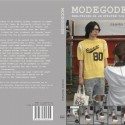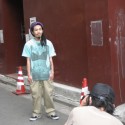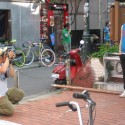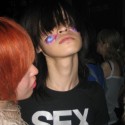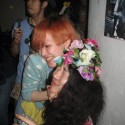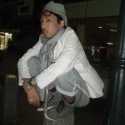05\08\2011
Written by Narayana
Fashion Gods
A while ago Otto von Busch, a professor from Sweden with a PhD in fashion, gave a lecture in Arnhem on bottom-up movements in fashion. His talk started with a hilarious image of Karl Lagerfeld, calling the shots as a true ‘pope of fashion’ from the top of the market. Of course Von Busch meant to mock the traditional fashion system. Moguls like Lagerfeld still have great influence on a global scale, but it is no news that style wise the eyes of forecasters around the globe are turning elsewhere. Amsterdam based researcher Anneke Beerkens recently published ‘Fashion Gods’, a book on some of these new fashion icons, to be found in the streets of Tokyo.
written by Esther Muñoz Grootveld
Anneke Beerkens, a cultural anthropologist with a big heart for fashion, has been researching fashion in the streets of Tokyo for a few years. When she came across a magazine called TUNE, visiting a shop in New York, she got even more intrigued. Like the more known magazine Fruits, TUNE covers creative DIY looks of ‘normal’ people in the streets of Tokyo, trying to capture the secret of Japanese sense of style. But opposed to what most people would expect when thinking of Japanese street wear, TUNE features obviously less extravagant looks than Fruits. And it shows menswear only. The relation between the young men featured in TUNE seems also more unclear. A bit tired of the well-known candy cane looks of her beloved Harajuku girls, Beerkens found a new challenge in the fresh menswear looks of TUNE. To investigate the source and development of this fashion tribe, there was only one place to go.
Arriving in Japan, Beerkens ticket into the underground world of Tokyo’s street fashion is a local hipster and shop-owner called Akira. Wondering the streets in the neighbourhood Shimokitazawa, Beerkens discovers his store Mikiri Hashin by accident and slowly manages to convince him to help her with her research. Akira, a much-featured face in TUNE, turns out to be a prime mover of one of the fashion tribes in Tokyo. Through researching his personal style and life, Beerkens finds out how Akira uses his charisma, shop and the magazine TUNE to influence young people around Japan. At the same time she manages to infiltrate a contrasting scene of colorful techno lovers that evolves around another store, named Candy. The result is an up-close and personal report of how these two groups manage to set the standard for young fashion in Tokyo. Both movements are described by Beerkens as so called neo-tribes, with local shops serving as almost religious places to hang out and worship leading figures like Akira. He serves as a style icon or fashion god, inspiring young people from all over Japan to travel to Tokyo to meet their role model in person and join the tribe.
Fashion Gods does not only give a deeper view into Japanese sense of style and the driving power of street photography that supports it. It also offers a look into the hearts of Japanese youth. More than anywhere in the world, young people in Japan turn away from the strict cultural boundaries of their parents, especially their fathers, who struggle through life as ‘sarariiman’ (office men). Young people make their youth last as long as they can, to maintain freedom. Acting out through fashion is a very direct way to express this. What Beerkens actually shows in her research is that fashion – at least in the streets of Japan – is not skin deep. By not only looking at clothing style, but also at the way the subjects of her research think and act, Beerkens finds out that for Akira and his followers fashion expresses their view on life. The way she describes her impressions of the tribes around Mikira Hashin and Candy is amusing, touching and most of all inspiring. A must read.
Esther Muñoz Grootveld is strategic consultant in design and fashion and will be living in East-Asia for the next year.


